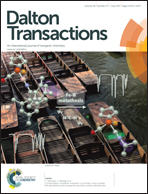Orange-red silver emitters for sensing application and bio-imaging†
Abstract
Highly fluorescent Au(I)@Ag particles (emission maximum at 635 nm) have been obtained from a mixture of AgNO3, HAuCl4 and glutathione. Au(I)@Ag particles containing Ag2 and Ag3 clusters are produced when the reaction mixture is subjected to a modified hydrothermolysis (MHT) reaction. The silver clusters make the solution intensely fluorescent and the Au(I) moiety provides long term stability to the silver clusters by withdrawing electron density from the silver clusters. The vacuum-dried aqueous fluorescent solution leaves a yellow solid that exhibits higher emissive properties when re-dispersed in non-aqueous solvents. Fluorescent Au(I)@Ag particles have been found to be cytocompatible and efficient candidates for live cell imaging. Addition of S2− ions selectively and successively quenches the fluorescence of Au(I)@Ag particles without any significant interference from common anions. Thus, sensitive detection of S2− is possible with the fluorescent Au(I)@Ag particles in water and water-miscible non-aqueous solvents. Furthermore, Pb(II) induced fluorescence enhancement of the solution containing Au(I)@Ag particles has been used to enable S2− detection free from interference by S2O32− and I−. The possibility of naked eye detection of S2− is also an additional advantage of this method as an orange color solution is developed exclusively with the S2− ion. Fluorometric determination of S2− has been rationalized for real environmental samples.


 Please wait while we load your content...
Please wait while we load your content...